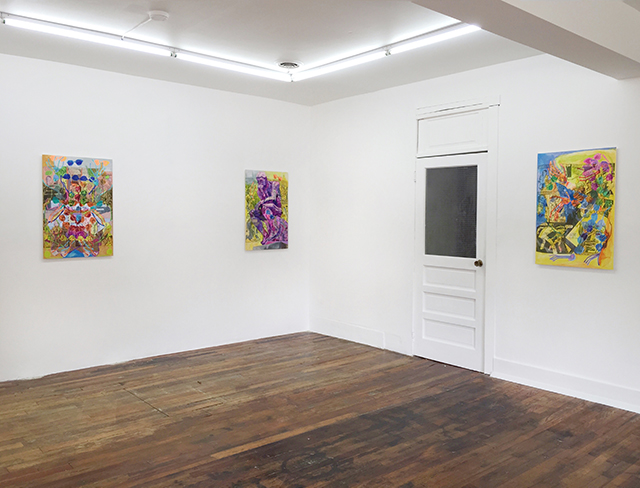If I was a little quiet on the blog last week, it’s because I was in a very quiet place.
Well, a place that’s sometimes quiet. But occasionally full of people—skateboarding indoors, throwing impromptu dance parties, blaring noise music—a far cry from the pastoral idyll one might associate with an artists’ retreat in the bucolic Hudson River Valley.
I was staying at Waterfront: a new, informal residency program at the Art / Life Center in Kingston, New York “that functions as a general structure within and around which vacation art can exist.” What, you might ask, does such a structure and/or “vacation art” look like? Pretty fun, as it turns out.
I arrived at the tail end of a weekend when several overlapping events and residents packed the space with guests. The small gallery had just hosted a closing for Joey Frank’s solo show Color Squonge, which featured comic-inspired paintings and handmade 3-D glasses. In the same space, Jeff DeGolier had installed “Microramp Boombox”—a sculpture that comprises a functional skating halfpipe wired with a car stereo—all constructed over the course of a day trip from the city. This happened to coincide with Willy Smart and Misael Soto’s residency—which itself was conceptualized as a meta residency-within-a-residency, parodying the programming of more formal artist retreats with scheduled activities every hour, on the hour for 48 hours. For each of the artists, there was at least one friend from Brooklyn who had come up for the weekend (Kingston is about 2 hours north of the city by car or train). This necessitated “Microramp Boombox” taking on yet another function: communal bed.
But come Monday morning, the Institute revealed itself to be a shockingly calm, almost monastic space. The odd little building consists of one open floor casually divided between a white-box gallery/living room and a kitchen/work area. Above that, an attic space has been converted to a long, cozy sleeping loft that evokes the best summer camp I never attended or a slumber party I didn’t want to end. Originally built as a bakery, the freestanding structure on the edge of town was purchased by the performance art legend Linda Montano in 1989 and renovated into the Art / Life Institute, which Montano describes as a wholehearted physical and emotional commitment—one likened to a spiritual process.
Earlier this year, Jill McDermid and Erik Hokanson—the directors of Brooklyn’s Grace Exhibition Space—bought the building with the intent to maintain the Art / Life Institute as a residency program, gallery, and performance venue. The couple own a nearby farm with several structures, a lake, and multiple acres that they’re hoping to convert into a larger residency. In the meantime, they have given the Art / Life Institute a thoughtful renovation with a light touch—maintaining many of the space’s idiosyncrasies and details from Montano’s years while opening it up and providing a cleaner gallery space. The Waterfront program that’s been occupying the Institute is the brainchild of former Regina Rex member Craig Poor Montieth and Patricia Margarita Hernandez, an MA candidate at the Bard Center for Curatorial Studies, across the river in Annandale-on-Hudson.
Patricia and Craig have been living in the space since the beginning of the summer, hosting rotating groups of artists, friends, performers, and audiences roughly every two weeks. The pair insist they have no mission statement. That’s refreshing to hear from two curators—practitioners in a field that often demands over-explanation and defense of even the most mundane tasks. Instead, they offer this definition: “Vacation art is what happens when a group of artists get together and enjoy themselves. What’s nice about this space is that it’s comfortable and welcoming. In New York City, galleries are everywhere, uniform, cold, and singular in their purpose. This leads to brief, disengaged encounters between visitors and proprietors. Here we hope to engage visitors on an intimate level as residents, artists and collaborators.”
My verdict: Mission-less Accomplished.






Comments on this entry are closed.
{ 1 trackback }